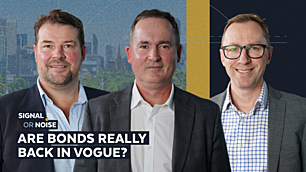The beginner's guide to bonds: Which product is right for you?
In case you've not read the first part of this series, I highly recommend you do so before delving into part two:

Now that you've made it through part one and understand why bonds are important in a diversified portfolio, we now have to take stock of all the options available in the bond market.
As we mentioned in the first piece, there is a US$133 trillion (and growing) opportunity in the global bond market though it has to be said that the US, Japan, and Europe are the behemoths of this asset class. Between those three regions, they control 95% of the global bond market. Australia is just 1% of the total global opportunity set.
But just because we are a small minnow does not mean we don't have attractive opportunities. Far from it, actually.
In this wire, we'll delve into part two of our series into understanding how bonds work. We'll be answering these questions:
- The different kinds of options available to Australian investors
- The opportunities and risks for each option
- What happens when it all goes pear-shaped?
The two major kinds of bonds
There are two major kinds of fixed income products available - government bonds and corporate bonds (sometimes called "credit" on American websites).
Within Australian government bonds, there are two main options for investors. Both are available to retail investors and can be purchased through the ASX in the same way you buy stocks (i.e. through a licensed broker).
The two main options are Treasury bonds (the price of the bond is fixed) and Treasury indexed bonds (TIBs) (the price of the bond is linked to inflation). Both Treasuries and TIBs are usually issued in blocks and each has its own coupon rate and maturity date, ranging from less than one year to 25 years. Naturally, it's up to you to decide which securities you want to purchase and you should only do so after speaking to a registered and qualified financial adviser.
The team at iShares have two products in this part of the market:
- (ASX: IGB) which looks after Treasury bonds/government-issued products
- (ASX: IAF) which provides investors with exposure to both government and corporate-issued credit.
There are also semi-government bonds available in the market. These are Treasury-like bonds but instead of being issued by Canberra, they are issued by your respective state or territory capital. Generally, though, you have to buy these through your various state Treasury corporations or buy into a fund that has exposure to this part of the market.
Corporate bonds, on the other hand, are more complicated. That's because there are many types of corporate bonds, with varying interest rates, maturity dates, and credit quality. In this case, you are not just betting on the bond making a capital appreciation while paying yield, you are also betting on the company's creditworthiness.
That creditworthiness is represented in corporate assets through the terms "investment grade" and "high yield". The trade-off here is simple - companies that are "investment grade" will issue debt at a lower interest rate than others with a poorer credit rating. But it also means you get a lower yield on your investment. The further down the quality curve you go, the more yield you could make but equally, the higher the risk that the company defaults and your money is left out in the cold.
Incidentally, credit ratings are issued by the major houses (Fitch, S&P Global, Moody's etc) and are determined based on a company's financial strength and past track record of paying down debt.
Can you buy bonds from other countries?
In short, yes and no. Yes, you can buy bonds from other countries but no, it isn't easy for Australian investors. The closest available option for retail investors in Australia is through bond ETFs. For instance, Global X ETFs have three products that offer exposure to three different parts of the US (which is the largest individual market of them all).
- ASX: USTB (Treasuries)
- ASX: USIG (Investment grade corporate bonds)
- ASX: USHY (High yield corporate bonds)
It should be noted that USTB is a passive product offering exposure to the 1-30 year bond markets in the US. Sometimes, this part of the market is referred to as the "belly" to the long end of the curve.
If you want shorter duration (i.e. bonds that expire in a much shorter time frame), you can access that VanEck 1-3 Month US Treasury Bond ETF (ASX: TBIL). "TBIL" incidentally is short for Treasury bills - which is the industry term for a bond with under 12 months' maturity.
What happens when a bond defaults?
While there are several risks that are associated with bonds (liquidity risk, interest rate risk, supply and demand factors, currency headwinds if you're investing in overseas markets), the one you need to be most aware of is default risk.
Default risk is the possibility that an issuer (more often than not, a company) will go bankrupt and therefore, cannot honour its obligations (i.e. your investment). If the bond issuer defaults, the investor can lose part or all of the original investment and any interest that was owed.
If this sounds awfully familiar and recent to you, it should. Earlier this year, Credit Suisse collapsed after a decade of management missteps, scandals, and significant losses. The collapse of Credit Suisse was a big deal for two reasons:
- It was a globally systemically important bank (GSIB), which meant that its collapse could have triggered a financial crisis. You may be more familiar with the other term for GSIBs - the "too big to fail" club.
- It provided an important lesson in default risk because, upon its collapse (and the subsequent takeover by UBS), Credit Suisse wrote down billions of dollars in bonds.
Without getting too into the weeds, the bonds which were written down were AT1s or "contingent convertible" bonds. AT1s are the riskiest type of bond a bank can issue. Thus, it carried big yields and big coupons.
In most countries, bondholders rank higher than shareholders in the list of people who get their starting capital back. But in Switzerland, there's a little-known rule that prevents this from happening if the financial institution is undergoing a restructure (which it has and is still doing). As a result, the bondholders lost out and their high risk, high payoff gamble was not successful.
This ends part two of the bonds explainer series. In part three, I will go through the value of a bond. How do you price a bond and determine if it's good value? Plus, we'll look at one of the other risks that can affect the price and yield of a bond - interest rates.
In the meantime, check out the brand new episode of Signal or Noise which provides a deep dive into bonds and the opportunity set available in today's market:

6 stocks mentioned
3 funds mentioned

